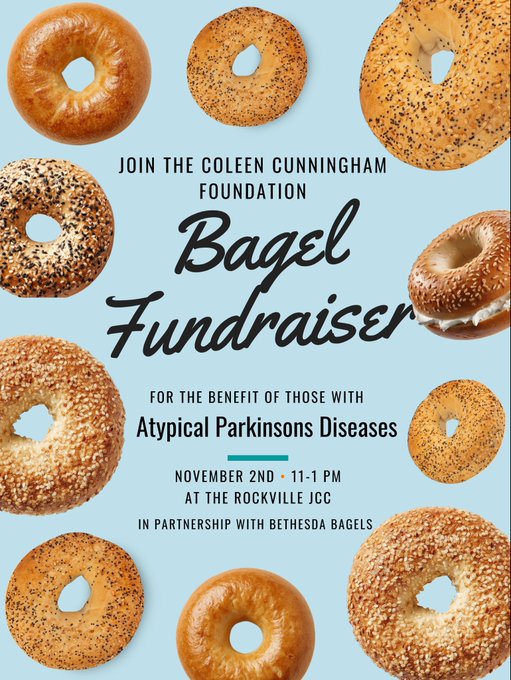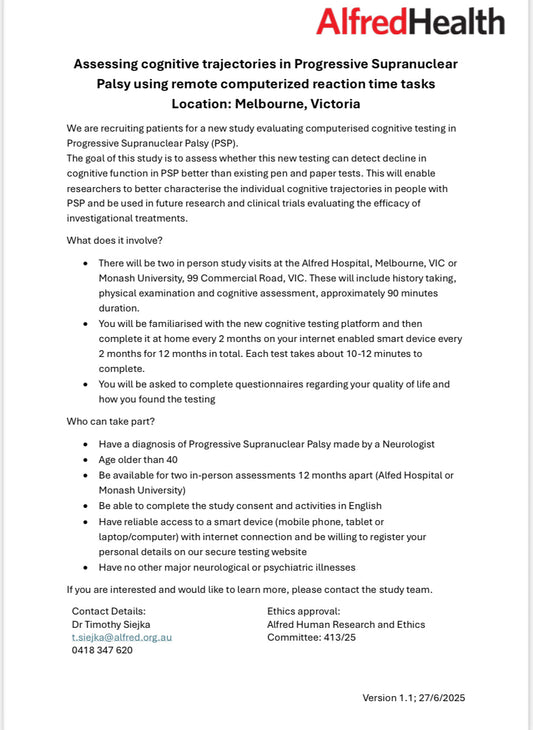It has been said there are four stages, but because there is so little research they are a guideline only.
Many people experience some stage four symptoms at stage one or overlap stages. Some never experience certain symptoms and then others can experience ones not listed. The impact it has on each individual varies dramatically.
Progressive Supranuclear Palsy (PSP) is a rare neurodegenerative disorder that affects movement, balance, vision, speech, and cognitive function. The disease progresses slowly over time, and its symptoms typically become more severe as the disease advances. While not everyone with PSP experiences the same symptoms or progression, there are generally four recognized stages of PSP:
-
Early stage: In the early stage of PSP, individuals may experience symptoms such as difficulty with balance and coordination, changes in gait, and problems with eye movement. These symptoms may be subtle and easily dismissed as normal aging or a different condition.
-
Mid-stage: In the mid-stage of PSP, symptoms become more pronounced and can include falls, speech and swallowing difficulties, and cognitive impairment such as problems with memory and executive function. Depression and apathy are also common.
-
Advanced stage: In the advanced stage of PSP, individuals may become wheelchair-bound and require assistance with daily activities such as eating, dressing, and bathing. Symptoms such as rigidity, spasticity, and involuntary movements become more severe.
-
End-of-life stage: In the end-of-life stage of PSP, individuals may be bedridden and require around-the-clock care. They may have difficulty swallowing, become more susceptible to infections, and experience other complications related to the progression of the disease.
It's important to note that not everyone with PSP will experience all of these stages, and the progression of the disease can vary widely from person to person. Additionally, some individuals may experience rapid progression, while others may experience a slower course of the disease.
Here is the four stages below in more detail;
Early stage:
May present via the fracture clinic, falls services, eye specialist or speech and language therapist. The early stage typically spans years 0-1.
> Ambulant.
> Occasional falls.
> Unsteadiness and poor balance.
> Possible visual problems affecting ability to read.
> Voice changes, for example reduced volume.
> Mood changes.
> Reduced socializing.
> Changes in mood and behavior, including apathy and anxiety.
Mid stage:
Many people reach this stage before diagnosis. Consider discussing advance care planning and advance decisions to refuse treatment. Consider referral to palliative care services. The mid stage typically spans years 2-3.
> Ambulant with aids.
> High risk of falls and injury.
> Visual problems affecting self-care abilities, for example eating and walking as unable to move eyes to see.
> Speech increasingly unintelligible.
> Inability to initiate conversation.
> Impulsivity (risky or impulsive behavior).
> Apathy.
> Dysphagia.
> High level of supervision required.
> Increasingly socially withdrawn.
Advanced stage:
Patients should be on GP palliative care register and have access to specialist palliative care.
The advanced stage typically spans years 3-6.
> Mobility significantly compromised, probably chair bound requiring a wheelchair for mobility.
> Significant visual problems.
> Significant muscle stiffness.
> Significant communication problems, but probably still able to understand.
> High risk of aspiration and pneumonia as a result of dysphagia.
> Pain.
> Increasing periods of sleepiness.
> Incontinence.
> Severely withdrawn socially.
> Dependent for most or all aspects of care.
End of life stage:
This stage is difficult to detect, but may be indicated by reduced levels of consciousness, inability to eat or drink, acute infection, a fall or major fracture, and rapid and significant weight loss. The end of life stage typically spans 6-8 weeks.
> Severe impairments and disabilities.
> Rapid and marked deterioration in condition.
> Decisions with regard to treatment interventions may be required, considering an individual’s previously expressed wishes (advance decisions to refuse treatment).
Discover the Benefits of Vielight Red Light Therapy for Atypical Parkinsonism


 Donate
Donate




131 comments
My wife has been diagnosed with Parkings for 11 years. She has more PSP syemtions and I would like to.know if she has been missed fiagnosed
Dear Malcolm,
I’m truly sorry to hear about your wife’s condition and the challenges you both are facing. It must be incredibly difficult to watch someone you love go through this and feel like the medical world isn’t giving you the answers you seek.
It’s essential to consult specialists who can better diagnose and guide you through the process. I recommend reaching out to the PSP Association in the UK. They offer support, advice, and resources to individuals and families affected by Progressive Supranuclear Palsy (PSP) and Corticobasal Degeneration (CBD). They might be able to guide you to specialists familiar with PSP and its differences from Parkinson’s Disease.
The PSP Association can help in several ways:
1. Offering advice on managing symptoms.
2. Providing information on the latest research and treatments.
3. Connecting you with local support groups and specialists.
4. Advocating for better care and recognition of PSP and related conditions.
You might find it beneficial to share your concerns with them and seek their guidance. Your feelings and observations about your wife’s condition are valid, and it’s essential to ensure she gets the best care possible.
Laura xx
I am convinced my wife of 63 years has PSP, I have tried many times for the Medical world to check or confirm, she was “diagnosed” 12 or 13 years ago with Parkinsons and that is what she has on her notes and that is what progressive medical professionals have continually treated her for although, she has none of the Parkinsons symptoms apart from shuffling of the feet from time to time, in the early gays, with no involuntary movements whatsoever even now when I believe she is in the final stages, the final statement from one of the consultants was “Vascular Parkinsons” The only treatment over the years has been various doses of Modapar (Dopamine), and never seems to have been a benefit to her. She is currently in a general ward of the hospital and has deteriorates quite rapidly in the few days she has been with them. Here in England it seems as if no one is attempting to treat what she has which I believe is PSP, she shows a large majority of the symptoms and progression you state. She had all her mental capabilities even if a little slow in processing the questions and conversations she was in. Now she drops to sleep at any time and answering questions seems to tire her out and brings on sleep. Is there anything I can do to help, she said yesterday she did not want “to live like this”
Malcolm.
Jean, thank you for sharing your husband’s journey with me. It’s unfortunate how often diagnoses can be missed or misinterpreted, especially with conditions that have overlapping symptoms. I’m glad you found a neurologist and a keen-eyed physical therapist who could guide you towards the correct diagnosis. It’s heartwarming to know that our website has been a valuable resource for you. Your proactive approach and dedication to your husband’s well-being are commendable. Nights can indeed be challenging; I’d recommend exploring night-time care options or strategies to ensure safety and well-being. Please remember, you’re not alone in this journey, and feel free to reach out if you need further information or support. Sending my best wishes to both you and your husband. 💕🙏 Laura
Sarah, my heart truly goes out to you and your family. The journey of finding a correct diagnosis can be an arduous one, especially when faced with the heart-wrenching reality of a condition like PSP. Witnessing the decline of a loved one, especially someone as central as a parent, can be deeply painful. I’m sending my heartfelt thoughts and prayers for strength, resilience, and moments of grace for both you and your dad. Remember, you’re not alone on this journey. If ever you need to reach out for support, advice, or simply someone to talk to, please know I’m here. I’ll definitely keep your dad in my prayers. God bless you both. 🙏💕 Laura